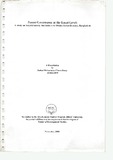| dc.description.abstract | Since early 80s Social Forestry has achieved special focus in Bangladesh forestry sector.
It has brought a significant shift in forest management through bringing both the
conservation of forest reserves and poverty reduction in development strategies. National
policy papers viz, national forest policy 1994, forestry sector master plan 1993, The
Forest (Amendment) Act 2000 and Social Forestry Rules 2004 unanimously put emphasis
on people-oriented forestry programme. Many scholars and development practitioners
also recognized the crucial role of local people in natural resources management (Marks,
1984; McCay and Acheson, 1987; Ostrom, 1990; Poffenberger, 1990; Hecht and
Cockburn, 1990; UNFAO, 1990; Blockhus et al., 1992; Bromley et al., 1992: Ascher,
1995; Agarwal,2000). Hence in pursuance of social forestry programme in Bangladesh,
local level social forestry institutions like participants' groups, social forestry
management committee (SFMC), tree farming fund committee, Upazilla environment and
forest development committee (UEFDC) were founded during early 90s. These
institutions are playing vital role to implement Social Forestry (SF) programme in
association with the existing local level FD institutions namely forest ranges and forest
beats. On the other hand, Forest governance, as a recent development discourse, entails
clarifying the relationships, rights, responsibilities and incentives among various actors on
the direction and nature of forest uses in a sustainable way (Recoftc, 2005) and IIED
(2005) views it as decisions and actions that remove the barriers and install the policy and
institutional systems, which spread local forestry success.
l-he study focuses on the legal foundations and performance of the local level forestry
institution, their compliance to the principles of good governance and overall implication
of forest governance in sustainable forest management. This study is contextual to the
social forestry programme in Sal forests of Bangladesh.
Study reveals that two local level social forestry institutions viz. social forestry
management committee (SI'MC) and Upazilla environment and forest development
committee (UEDFC) have the potentiality to ensure governance in forest management
through collaboration of local forest dependent communities, local public agencies,
NGOs, civil societies and forest department as legal custodian of forest reserves. At this
point, these actors demonstrate a structured initiation in ensuring governance through participation of a wide range of stakes, in a visible consensus manner, towards some set
strategic visions, and effective mechanism of guaranteeing rule of law. The study also
reveals that the committees display a positive drive through their efficiency,
accountability and transparency in transactions with the stakeholders. However, there are
some challenges yet to be resolved. These are selecting right and the most eligible local
dependents as SF participants, building capacity of both the rights holders and duty
bearers, conflict resolution and devolution of financial and administrative power to these
institutions. lt is largely evident that FD as land owning agency and local elites
(administrative and political) still play dominant role in SF programme implementations,
which often impede ensuring good forest governance, Furthermore, though the tree
farming fund (TFF) is acknowledged for sustainability of SF programme, the institutions
in practice, are neither capable to handle the funds nor transparent in its transactions.
The study concludes with ranking the institutions in a gauge of l-51, with respect to five
principles of good governance (adopted from Graham et. al. 2003) and found that
UDEFCachievedanaggregaterank of 2.5 i.e,rightinbetweengood (2)and moderate(3)
and the SFMC ranks at 2.69, i.e. closer to moderate (3). This implies that LJE,FDC's
performance is better than the SFMC in ensuring good forest governance through the
social forestry programme. Consequently, more emphasis should be given to make the
SFMC more functional and effective since it paves the basis of SF programme as well as
the most vital starting point towards ensuring forest governance. However, the progress
so far achieved in the SF programme in the country is a reflection of external
backstopping from donors, project supports and policy makers; and made the space for
local actors to create demand for further refinement, update and improving social forestry
to meet their needs as well as preserving biological diversity in the forest reserves.
Although the study exhibits a fragmented scenario of social forestry programme and
localized in context, it may be a food for thought for the actors in social forestry
programme and would be useful for directing further research by the academicians. | en_US |

